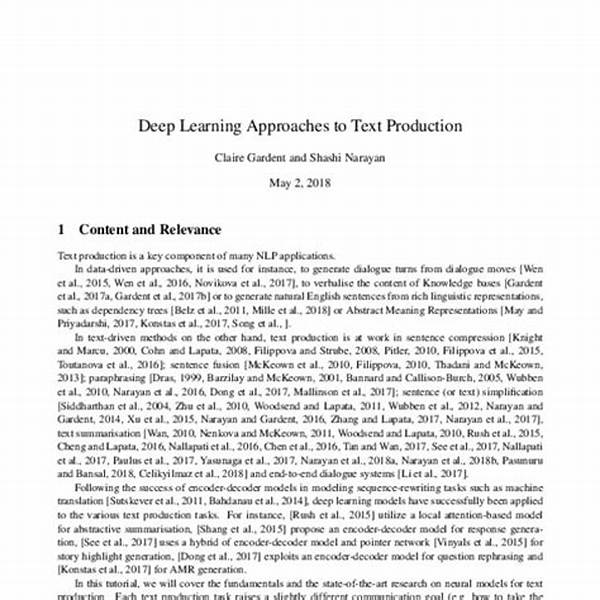Deep Learning for Text Production
In a world where technology rapidly evolves, “deep learning” emerges as a groundbreaking technology, transforming the landscape of text production. This innovative approach has redefined how we understand and generate written language, offering unprecedented possibilities for businesses, writers, and tech enthusiasts. When we delve into “deep learning for text production,” we discover a sophisticated neural network model focusing on mimicking human-like text creation. Unlike traditional programming that relies on explicitly set rules, deep learning identifies patterns within vast amounts of data, learning context and nuance in ways previously unimaginable. With its transformative potential, this advanced technology isn’t just an option—it’s becoming an essential tool in the arsenal of companies seeking competitive edge and efficiency in content production. Imagine crafting immersive narratives, insightful news articles, or catchy marketing content with enhanced speed and precision. This is the promise of deep learning for text production.
Our journey into deep learning for text production begins with understanding the technology itself. At its core, deep learning simulates the human brain’s neural networks, enabling machines to recognize patterns and classify data. When applied to text production, it involves processing extensive datasets to grasp language structure, syntax, semantics, and sentiment. The outcome? Machine-generated content that is coherent and contextually aware. Many industries have embraced this technology, from journalism and marketing to customer service and education, driving towards a future where machines and humans collaborate to produce quality content efficiently.
The advantages of incorporating deep learning into text production are manifold. Firstly, consider the sheer speed and scalability. A task that might take a human hours or even days can be completed within seconds by these systems, making it ideal for generating reports, articles, and personalized content at scale. Moreover, deep learning models can adapt and improve over time, learning from new datasets and continuously enhancing text quality. This adaptive nature ensures that content remains relevant, accurate, and tailored to evolving consumer preferences.
Moreover, deep learning for text production isn’t just about efficiency—it also enhances creativity. By analyzing linguistic patterns and cultural nuances, machines can suggest novel ideas and unique perspectives, inspiring writers and content creators to think outside the traditional boundaries. This synergy between man and machine not only boosts productivity but also promotes innovation, leading to storytelling that resonates more powerfully with diverse audiences.
Revolutionizing Text Production with Deep Learning
Now, let’s delve deeper into the practical applications of deep learning for text production. This transformative technology has become a powerful ally for businesses seeking to revolutionize their content strategies. The ability to generate high-volume content without compromising on quality is invaluable for digital marketers aiming to capture the attention of their target audiences.
Harnessing the Power of Deep Learning
Deep learning algorithms process colossal datasets, learning from the structure and meaning behind the data, just like a diligent student comprehend the nuances of a new language. What sets these systems apart is their ability to produce human-like text while understanding the context, tone, and style that makes content engaging and relevant. This competence enables businesses not only to sound more relatable and authentic but also to foster stronger connections with their customers.
Moreover, these algorithms have now moved beyond basic text generation tasks. They can perform sophisticated tasks such as sentiment analysis, summarization, and language translations. For instance, deep learning-powered chatbots are increasingly becoming customer service mainstays, efficiently handling inquiries with personalized responses that reflect genuine understanding and empathy.
Exploring the Benefits of Deep Learning in Text Production
1. Efficiency and Scale: Deep learning enables rapid text generation, bypassing the traditional bottlenecks of human writing processes.
2. Consistency and Quality: Machines maintain consistency across content while learning and improving continuously.
3. Innovation and Creativity: Provides new ideas and angles for human creators, enhancing collaborative storytelling.
4. Personalization and Relevance: Tailors content to specific audiences using data-driven insights.
5. Cost-Effectiveness: Reduces costs in content production while maintaining high quality.
Harnessing deep learning for text production is not just about technological advancement—it’s about redefining how we engage with language, communicate ideas, and tell compelling stories.
Discussion Points on Deep Learning for Text Production
In conclusion, whether you are a business leader, a writer, or a tech enthusiast, diving into deep learning for text production offers a glimpse into the future of content creation—one that promises to be more efficient, innovative, and aligned with the dynamic needs of our global digital landscape.

